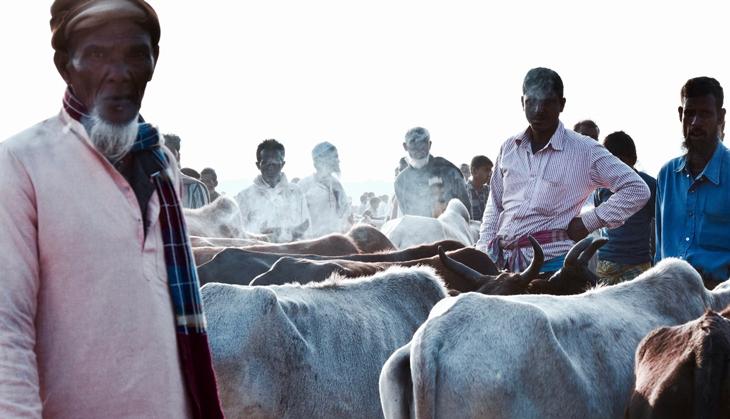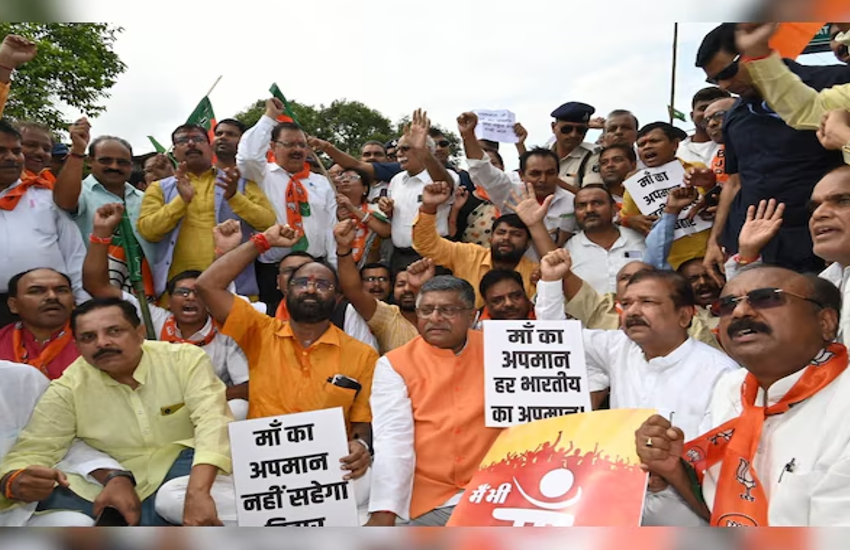Dismal figures: Between gau rakshaks & cattle smugglers, how is India protecting the holy cow?

The cow has been central to the narrative of the Narendra Modi government like it has never been under any other Union government in India before. Bovine was always considered divine by a large section of Hindus, but post-2014, the animal's status seems to have been elevated from a mere animal or an economic resource to a hallowed symbol of nationhood. But how serious is the government really about these cows?
Despite New Delhi's hard talk that no cows be allowed to cross the border, and Bangladesh not giving up on eating beef, figures indicate that cattle smuggling is thriving. And most of the cattle that ends up in abattoirs in neighbouring Bangladesh, come from the cow belt – from Rajasthan, Haryana and UP, among others, states who have cracked down on violators of strict cow protection laws with gusto; and self-styled gau rakshaks, with their saffron bandanas, have taken to patrolling the highways in utility vehicles, accosting cattle transporters. They are ready to kill humans to save cows and they have also done it in some cases.
The Border Security Force (BSF) foil, on an average, almost 57 cattle smuggling attempts every day in 2016. A senior BSF officer, Commandant Deepak Mondal, was crushed to death in Sonamura, Tripura in October this year when he challenged a gang of suspected cattle smugglers.
The National Crime Records Bureau's yearly data for 2016, which for the first time carried figures of cattle seizure by the BSF, says that a staggering 1,68,801cattle were seized in 2016, in a total of 20,903 cases.
Recent figures by the BSF, which patrols the more than 4,096 km-long India-Bangladesh border, show that a further 1,20,578 cattle were seized in the ten-month period from January to 31 October 2017. The numbers may rise for the winter months when fog will offer a better opportunity to the cow rustlers.
According to a Parliamentary Committee report, the BSF seized –
– 1,20,724 cattle in 2012
– 1,22,000 in 2013
– 1,09,999 in 2014
– 1,53,602 in 2015
All of these numbers pertain to the eastern border, with Bangladesh since no cattle crossings happen on the border with Pakistan, as the BSF Spokesperson says.
To put things in perspective, especially on the relatively calm border with Bangladesh, the BSF seized just 46 arms in 2017 and intercepted 87 Rohingya refugees, whom the NDA government sees as a national security threat.
Essentially implying that most of the energy of this border force is going in stopping the movement of cows, the most lucrative commodity on this border.
And yet, this data offers no estimate of how many cattle were, in fact, able to cross over to the other side, made to swim in the many rivers, including the mighty Brahmaputra in lower Assam with banana plants tied to them, or just crudely thrown over the fence through improvised wooden pulleys, besides crossing over by the usual methods of cutting the fence.
This data of seizures could mean anything, as a BSF official put it.
“It could mean there is more vigil. But at the same time, since there is no concrete data, it could also mean that it is business as usual, and the nexus continues to thrive,” he says.
The price to pay
So has the smuggling of cows, which reports say is pegged at Rs 20,000 crore a year, gone down?
“It has certainly fallen drastically,” claims PSR Anjaneyulu, IG –South Bengal of BSF, one of the hotbeds of cattle smuggling.
The senior BSF official says demonetisation and change in rules of the cattle trade are major reasons for the fall in numbers. And that advanced patrolling techniques too, have given the forces an upper hand when it comes to apprehending the cow runners.
There has been a considerable improvement in the capabilities of the BSF with more advanced weapons and gadgets at its disposal. The border guards are now armed with night vision equipment and there are speedboats to guard the riverine border.
In the border town of Dhubri in lower Assam, one of the hotbeds of cattle smuggling, the trade is now a fraction of what it used to be till 2015 when Rajnath Singh visited the Northeast and called for strict measures.
Abu Tahir Ali Bapari, a senior lawyer in the predominantly Muslim border town, where a section of people have prospered by just walking cows to the border fence, said that cattle crossings have come down ever since the BSF deployment increased and the government cracked the whip.
Reports from Bangladesh, too, indicate that the illegal trade where the smugglers, or traders as they are called for they would just pay the 500 Taka per cow as tax, would sometime trade gold for cows, has come down.
A recent report in the Nikkei Asian Review quotes Robiul Alam the Secretary General of the Bangladesh Meat Merchants Association on how the number of cows who cross the border has come down to two million from three and a half million cows annually.
That beef prices have risen by at least 20% is another indication that the supply lines have shrunk.
A Daily Star report earlier in August 2017 said how beef was selling for as much as much 510 Taka a kilogram when it sold for less than 300 Taka a kilo in 2015. During Ramazan, in Dhaka, the authorities even put a ceiling on the beef prices.
Silver lining?
However, a section of Bangladeshis is happy over the crackdown by the BJP government. Bangladesh government data shows that the number of cattle farms in Bangladesh has swelled to 522,000 from just over 33,000 in 2011, according to the report in Nikkei Asian Review, indicating that more people are taking up cattle rearing in the country.
But the high number of seizures and meat traders in Bangladesh still points to the fact that a significant number of cattle are making their way across the part fenced, part riverine border which separates the two countries.
Another BSF official who has served in the Northeast said that the high number of seizures indicates that with strict cow slaughter rules in other states, a large number of people are still taking the risk. There is a huge incentive to transport the cows to the border and try to push them to the other side where they fetch a hefty price, the BSF official explained.
Cows from as far as Rajasthan, routinely find their way to border states like West Bengal and Assam. The journey may sometime include packing them in containers, then shifting them into smaller vehicles as they come closer to West Bengal or Assam and then finally walking or making them swim across the border.
A cow which may cost a few thousand if it is bought in Rajasthan or Haryana, or nothing when it is stolen, becomes an animal worth over Rs 40,000 once it crosses the border.
“The North Indian variety, in fact, fetch a premium in comparison to the local cow varieties which are smaller,” a BSF official says.

Other routes
Bengal and Assam, the first to fall on the route to Bangladesh, remain the obvious hotspots while a few cattle make their way through Meghalaya and Tripura as well.
“The most affected areas of cattle smuggling are Nadia, Murshidabad, Malda, Dakshin Dinajpur, Uttar Dinajpur, Raiganj, Siliguri in the State of West Bengal and Dhubri in Assam,” states the Parliamentary Committee Report on Border Security: Capacity Building and institutions which was tabled in April 2017.
“It is difficult for the cattle smugglers to bring these animals all the way to Meghalaya,” says a BSF official.
“Plus there is an obvious demand of beef in the state which has to be taken care of. And that leaves a very few cattle which could be sent across the border,” he adds.
Yet, there has been a rise in seizures in Meghalaya in the last few months which the local officials are reportedly attributing to the shifting of the cattle smuggling syndicates in neighbouring Assam. Over 10,000 cattle have been seized in the Meghalaya sector alone.
Similarly, a senior official in Tripura, too, claims that the cattle crossings on the border in the state are minuscule in comparison to West Bengal.
“A large part of the border in Bengal is riverine which is difficult to keep a check on,” says a senior officer in West Bengal. Plus, there are no concrete laws to stop cattle from travelling to these border states.
Repeat offenders
Many a time, the same cow may undertake multiple journeys to the border, with its courier in tow, mostly a local who earns a cut on every cow which manages to cross. There is a big chance that the BSF may have seized the same cattle more than once, as a BSF officer explained.
Once the cattle are seized, it is handed over to the Customs Department to be auctioned. The rate of auction are still lucrative for the handlers to buy the cattle again and make a fresh attempt.
“The local varieties cost less. While the bigger ones which are brought in from North India are auctioned at a higher price,” says an official. And since these cattle haats are right in these border towns, transporting them back to border areas again is not difficult.
“It is like you buy something from Chor Bazar at Lal Qila and it gets stolen again,” the BSF official explained building an analogy of this bizarre situation.
“The Committee notes that the auction of seized cattle by customs officials is misused by the cattle smugglers who keep buying the auctioned cattle again and again,” the Parliamentary Committee report states.
The Committee had recommended a ban on auctioning of seized cattle in the states bordering International Border and requesting the Customs Department to arrange for transportation of the seized cattle to states not near the border and hold auctions there.
The Committee also recommended that the Customs Department “raise the minimum benchmark price of the seized cattle to prevent their re-selling to the persons involved in smuggling of cattle.” But, it is easier said than done, especially in light of limited capacity of the department.
The Committee also recommended a crackdown on the many cattle haats that dot these regions and serve as the local market places. However, the MHA and the government of West Bengal are yet to act on this.
“MHA has been requested to take up the issue with Chief Secretary, Govt. of WB for shifting of cattle haats beyond 8 kms from the Indo-Bangladesh border and the case is still pending with MHA,” the BSF spokesperson says.
Meanwhile, chasing cows may sometime mean serious injuries or loss of life for the BSF personnel as the case of Commandant Deepak Mondal shows.
Edited by Jhinuk Sen
First published: 6 December 2017, 21:46 IST




![BJP's Kapil Mishra recreates Shankar Mahadevan’s ‘Breathless’ song to highlight Delhi pollution [WATCH] BJP's Kapil Mishra recreates Shankar Mahadevan’s ‘Breathless’ song to highlight Delhi pollution [WATCH]](https://images.catchnews.com/upload/2022/11/03/kapil-mishra_240884_300x172.png)

![Anupam Kher shares pictures of his toned body on 67th birthday [MUST SEE] Anupam Kher shares pictures of his toned body on 67th birthday [MUST SEE]](https://images.catchnews.com/upload/2022/03/07/Anupam_kher_231145_300x172.jpg)






